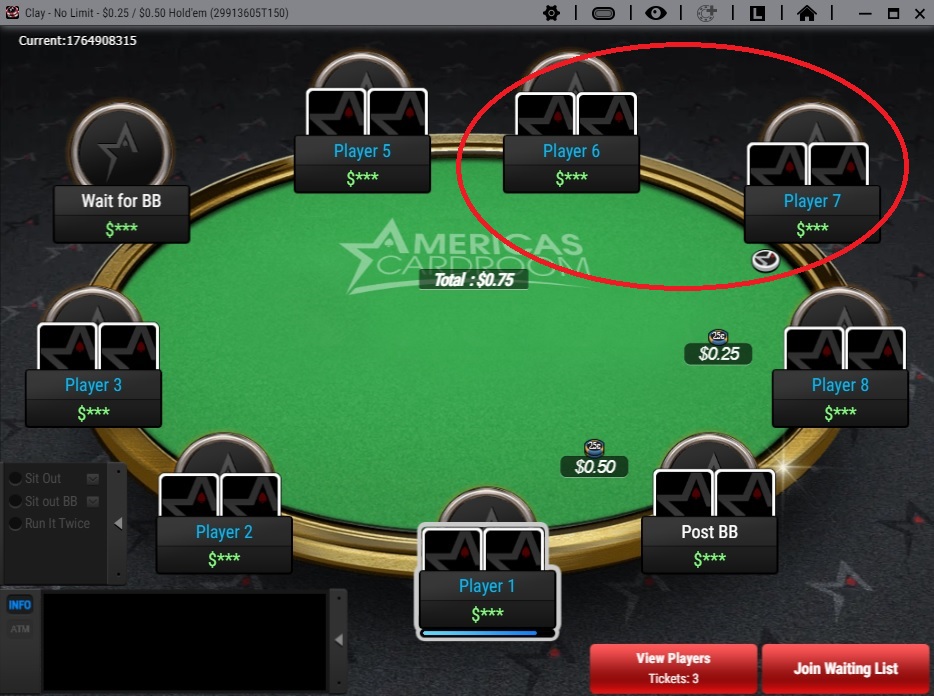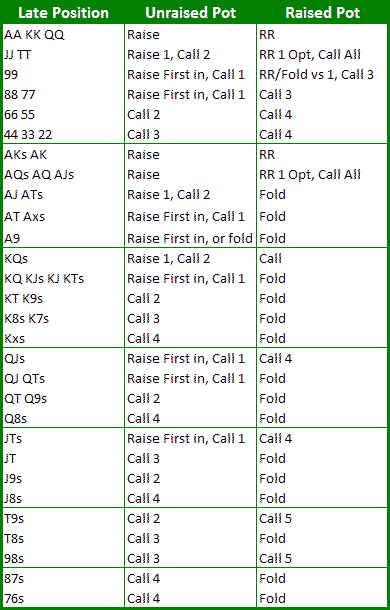
Contents
Playing from a late position in Texas Hold’em offers several advantages and opportunities to leverage, as you have more information about your opponents’ actions before you decide what to do. However, with this advantage also comes responsibility.
Late position in Texas Holdem refers to the last two seats on the table – the cutoff and the dealer button seats. In the graphic above, you’ll see these seats are occupied by Player 6 and Player 7. Note the dealer button is in front of Player 7.
Here is a good way to play your hand in late position, check out the hand chart below:
Late Position Hand Chart

Understanding the Late Position Hand Chart
The first column shows you all the playable hands you may play in late position. If the pot has not been raised to you, then you can act based on the second column. The number after the Raise or Call refer to how many players are in before you. For example, if you are holding TT in an unraised pot, and one player has entered the pot before, then you would raise your hand. If there are two players that have entered the pot before you, then you would just call. With the same hand in a raised pot, you may optionally reraise if only one player has raised before you, or just call.
This chart is a solid way to play late position but of course it is a good idea to make slight changes based on any reads you pick up.
Here are some ideas to help you maximize your benefits when playing in late position:
Play More Hands: One of the most significant advantages of being in late position is that you can play a wider range of hands profitably. Since you’ll have more information about your opponents’ hands, you can make more informed decisions on how to proceed.
Take Control: Being in late position gives you the opportunity to control the pot size based on the strength of your hand and the actions of your opponents. If the action has been checked to you, you can often steal the blinds by making a reasonably sized bet.
Leverage Position for Bluffs: Late position is an excellent place to bluff because if everyone checks to you, it may indicate weakness. You can then place a bet and possibly win the pot right there.
Value Betting: Being last to act means you can see how your opponents react to the flop, turn, and river. If your hand is strong and you perceive your opponent to be weak, you can bet for value and expect to get called by worse hands.
Read Your Opponents: Pay attention to how your opponents play. If they’re playing very tight, you can take advantage of this by playing more hands. If they’re playing loose, you can tighten up and wait for strong hands to take their chips.
Be Aware of the Button: The button is the best position in poker. Use this position to apply pressure on the blinds, steal pots, and control the action at the table.
Adjust Based on Stack Sizes: Be aware of your stack size and the stack sizes of your opponents. This can affect how you should play hands. For example, you may need to be more cautious if you or your opponent has a short stack, while you can take more risks if you both have deep stacks.
The cutoff and button positions in Texas Hold’em are the most powerful spots at the table due to their positional advantage. Let’s explore a more detailed strategy for these two positions:
Cutoff Position Strategy
Loosen Your Range: The cutoff is a great position to start playing a wider range of hands. You can play all pairs, most suited connectors, and a larger number of high-card hands (like A9, KT, QJ, etc.).
Stealing Blinds: If the action folds to you in the cutoff, you should be looking to raise and steal the blinds a significant percentage of the time. The hands you do this with will depend on the tendencies of the button and blinds. If they are tight, you can be more liberal in opening hands; if they’re loose or aggressive, be more selective.
3-Betting: You can also take advantage of the position to 3-bet more frequently, especially against a loose opener in early or middle position.
Floating: Against an aggressive player to your right, consider ‘floating’ more often (calling with a weak hand on the flop with the intention to bluff on later streets).
Button Position Strategy
Play an Even Wider Range: You can play an even wider range of hands on the button than the cutoff because only two players act after you.
Frequent Stealing: Your primary strategy when action folds to you on the button should be to raise and attempt to steal the blinds.
Flat Calling More 3-bets: If you are 3-bet by the small blind or big blind after trying to steal, you can afford to call more often due to your positional advantage. You can take a flop and use your position to take the pot away on later streets.
Control the Pot Size: Use your positional advantage to control the pot size. If you’re ahead, you can build the pot. If you’re unsure, you can keep the pot small and get to showdown more cheaply.
Applying Pressure: From the button, you can apply a lot of pressure on the blinds, especially if they are trying to defend too often. They will be out of position for the rest of the hand, making it difficult for them to play back at you without a strong hand.
Heads-up Pots: When you are on the button, you’ll often find yourself in a heads-up situation, which means you should adjust your hand values accordingly. Some hands that perform poorly in multi-way pots, like KJo or QTo, perform much better heads-up.
Remember, while playing a wider range from late positions is profitable, always consider the playing styles of your opponents and their tendencies. Adjust your play accordingly, and always stay observant and adaptable.
Leave a Review
Submit your review | |







